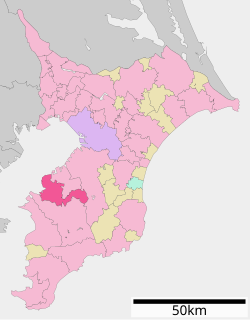Kisarazu
Kisarazu
木更津市 | |
|---|---|
 Center of Kisarazu | |
 Location of Kisarazu in Chiba Prefecture | |
| Coordinates: 35°22′33.5″N 139°55′0.6″E / 35.375972°N 139.916833°E | |
| Country | Japan |
| Region | Kantō |
| Prefecture | Chiba Prefecture |
| Government | |
| • Mayor | Isao Mizukoshi (since April 2002) |
| Area | |
• Total | 138.95 km2 (53.65 sq mi) |
| Population (February 2016) | |
• Total | 134,239 |
| • Density | 966/km2 (2,500/sq mi) |
| Time zone | UTC+9 (Japan Standard Time) |
| - Tree | Camellia |
| - Flower | Satsuki azalea |
| Phone number | 0438-23-7111 |
| Address | 1-1 Shiomi, Kisarazu-shi, Chiba-ken 292-8501 |
| Website | Official website |



Kisarazu (木更津市, Kisarazu-shi) is a city located in Chiba Prefecture, in the Kantō region of Japan. As of February 2016, the city had an estimated population of 134,239 and a population density of 966 persons per km². The total area was 138.95 square kilometres (53.65 sq mi).
Geography
Kisarazu is located in the western part of the Bōsō Peninsula. The Tokyo Bay Aqua-Line, a bridge-tunnel across Tokyo Bay, connects Kisarazu and the cities of Kawasaki and Yokohama in Kanagawa Prefecture.
Neighboring municipalities
Chiba Prefecture
History
Early History
The area of modern Kisarazu has been inhabited since the Japanese Paleolithic period, and numerous remains from the Jōmon, Yayoi and Kofun periods have been found within the city limits. The area also is prominent in the Yamatotakeru mythology. Under the Ritsuryō system of the Nara period, the area became part of Kazusa Province. The area was contested between the Late Hōjō clan, Takeda clan and Satomi clan during the Sengoku period. During the Edo period under the Tokugawa shogunate, part of the area was under the control of the feudal domain of Jōzai, with large portions as tenryō territory controlled directly by the Shogunate and administered by numerous hatamoto.
Meiji Restoration and Kisarazu Prefecture
Kisarazu was part of the complex reconfiguration of administrative areas at the start of the Meiji period. In 1871, as part of the abolition of the han system, the Sakurai Domain, located partly in Kisarazu, was abolished and "Sakurai Prefecture" was established.
In November of the same year, the prefecture was combined with the former Awa Province and Kazusa Province to form "Kisarazu Prefecture". The prefectural seat was established in the present-day Kaifusa district of Kisarazu. Kisarazu Prefecture was established two years later in 1873. It was combined with Inba Prefecture to form present-day Chiba Prefecture.
World War II and Post-War Period
Kisarazu was developed as a center for military activity as part of the militarization of Japan in the 1930s. In 1935-1936 the Imperial Japanese Navy, established the Kisarazu Air Field for the Kisarazu Air Group on landfill in the northern part of Kisarazu to protect Tokyo from attack. The base served as an arsenal for the IJN, and employed up to 17,000 workers during the war. It was this site that received the remains of Admiral Isoroku Yamamoto after being trasported back to Japan aboard Musashi. The Nakajima Kikka, Japan's first jet-powered aircraft, was tested at the base in 1945. The base was used by the United States Air Force from 1945 as "Kisarazu Air Base". In 1956, the base was officially transferred to the control of the Japan Air Self-Defense Force (JASDF).
Kisarazu Town, founded on April 1, 1889, was expanded through merger with neighboring Aoyagi Town on March 31, 1955, and again through merger with Amaha Town and Osawa Town on April 25, 1971. Kisarazu attained city status on November 3, 1942.
Economy
Kisarazu has a mixed economy based on commercial fishing, agriculture, and heavy industry along its Tokyo Bay shoreline. It serves as the commercial center for central Bōsō Peninsula, and is increasingly a bedroom community for neighboring Kimitsu and the Kawasaki – Yokohama metropolis across Tokyo Bay.
Transportation
Railway
- JR East – Uchibō Line
- JR East – Kururi Line
- Kisarazu - Gion - Kazusa-Kiyokawa - Higashi-Kiyokawa --- Makuta
Highway
- Tateyama Expressway
- Tokyo Bay Aqua-Line
- Ken-Ō Expressway
- Japan National Route 16
- Japan National Route 127
- Japan National Route 409
- Japan National Route 410
Seaports
Education
- Seiwa University
- Kisarazu has 20 public and one private elementary school, 13 public and two private middle schools, and two public and three private high schools.
Local attractions
- Nakanoshima Park
- Enmyō-in - Buddhist temple
- Kōzō-ji - 30th temple in the Bandō Sanjūsankasho the circuit of 33 Buddhist temples in Eastern Japan
Sister city relations
 Oceanside, California, United States,[1] from June 29, 1990
Oceanside, California, United States,[1] from June 29, 1990
Noted people from Kisarazu
- Haruo Oka - musician
- Hideki Takahashi - actor
- Akira Nakao - actor
- Kaori Fukuhara – voice actress
- Miyuki Miura – karate master
In popular culture
Kisarazu's profile has been raised in recent times by the popularity of the TV show and subsequent film, Kisarazu Cat's Eye, which were set and filmed in the city.
Gallery
-
JGSDF Kisarazu Air Field
-
Yana River, Kisarazu
-
Umi-hotaru (Sea firefly) Parking Service area and Kisarazu
-
Yassai-Mossai (Sokonoke-Sokonoke) Dancing Event on August 14
-
Kisarazu Port Festival (Minato-Matsuri) Fireworks Festival on August15
References
- ^ "US-Japan Sister Cities by State". Asia Matters for America. Honolulu, HI: East-West Center. Retrieved 20 November 2015.
External links
![]() Media related to Kisarazu, Chiba at Wikimedia Commons
Media related to Kisarazu, Chiba at Wikimedia Commons










